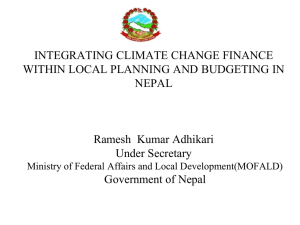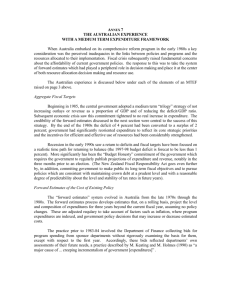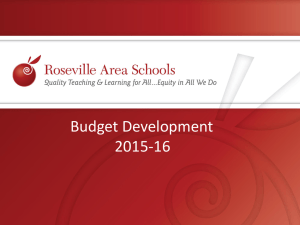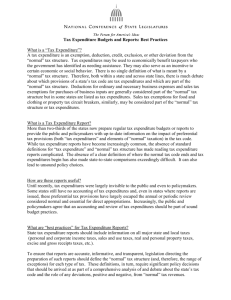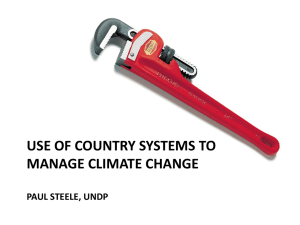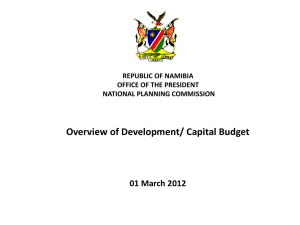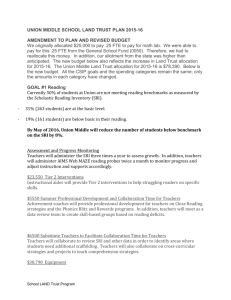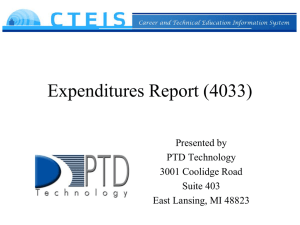CPEIR Clinic - Low Emission Capacity Building Programme
advertisement
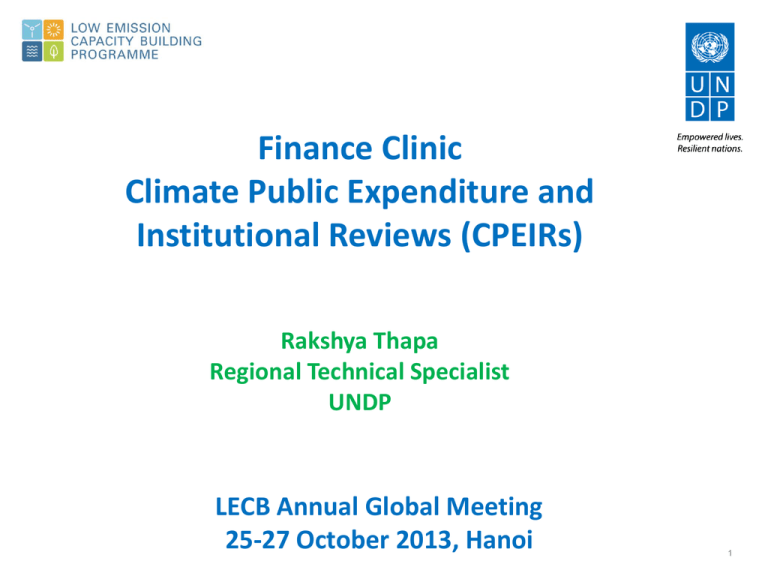
Finance Clinic Climate Public Expenditure and Institutional Reviews (CPEIRs) Rakshya Thapa Regional Technical Specialist UNDP LECB Annual Global Meeting 25-27 October 2013, Hanoi 1 Overview • • • • CPEIRs – Introduction (20 mins) Q&A and Discussions (15 mins) Group Exercise (45 mins) Reporting on the Group Exercise (10) 2 Introduction Objective: To review allocation, management and results of public expenditures related to climate change Core aspects: • Assessment of current policy priorities related to climate change • Review of institutional arrangements • Analysis of public expenditure and its relevance to climate change How to quantify & track climate change related expenditures in the national budgetary system? 3 Policy, planning and budgeting cycle Objective: To review allocation, management & Policy makingof process results public expenditures related to climate 1. REVIEW POLICY change Key-question: How is climate change2.reflected in SET POLICY AND PLANNING 6. EVALUATE AND AUDIT national policies, institutions & publicUNDERTAKE expenditures? ACTIVITY Implementation: Led by government through cross 5. MONITOR activities and 3. MOBILIZE AND government steering group chaired by Ministry of ACCOUNT for expenditure ALLOCATE RESOURCES Finance or Planning CPEIRs build on WB methodology for 4. IMPLEMENT PLANNED ACTIVITIES PER/PEIR/PEER Budgetary process Add “climate-relevance” dimensions to analysis 4 The CPEIR Methodology • Methodology builds upon the WB Public Expenditure • The approach : – compilation of relevant documentation derived from official sources and public documents. – Individual semi-structured interviews with key informants – research largely at the national level but local analysis included • Studied led by a multidisciplinary team of researchers and overseen by cross government steering group 5 The CPEIR Methodology The analysis constitutes: • Review of policies, institutional arrangement and public expenditure across the whole of government • Define what constitutes ‘climate relevant’ expenditure • Classify public expenditure into categories of varying levels of climate relevance – Identify budget line codes with High, Medium and Low relevance to climate change • Composition of public expenditure may vary from country to country comprising both budgetary and off budget expenditures 6 Policy, institutional & expenditure findings • Link climate policy to budget, so climate strategies are prioritized and costed • Link budget to climate policy, so climate is part of budget framework • Coordination by finance & planning ministries with technical input from environment and line ministries • Large proportion of climate relevant’ expenditure embedded in sectors with other primary objectives • Local government also a key channel for climate finance • Between 3-17% of the total budget deemed to be ‘climate relevant’ 7 Expenditures & sources Climate relevant expenditures as a proportion of total expenditure & GDP 8 Few major players with local channels key Highest climate relevant spending agencies as proportion of total ‘climate budget’9 Indonesia Case Study Mitigation Fiscal Framework • Assess the public expenditure to realized GHG reduction target of 26% by 2020 • Reviews expenditure of climate change actions and its cost effectiveness • Focus sectors such as forestry, peatlands, energy, transport • Current patterns of expenditure meet only 20% of the national targets • Therefore, further action and increase in financing required • Inter-ministerial coordination necessary to institutionalize and manage the MFF • Considering the development of budget marking and scoring system 10 Lessons Learned • CPEIRs should not be a one off exercise. Periodic review helpful on how response to climate change evolving. • Need for internationally consistent methodology for defining climate relevant expenditures • Focus on the “dirty” expenditures which may undermine the national climate response • Climate Fiscal Framework be developed with Ministries of Finance and Planning – to identify potential sources of funding and how they can be best accessed, combined and sequenced – Outline role of different sectors of economy 11 Conclusions CPEIRs important tool in public expenditure management • Set a baseline and budget execution history against which future expenditures can be measured and monitored • Encourage a holistic & comprehensive view of climate expenditures • Functional markers to climate change expenditures to track more easily over time • Foundation to establish baseline and MRV framework for financial support for LEDS 12 Thank you For further information please contact rakshya.thapa@undp.org CPEIRs Methodological note & Asia-Pacific case studies: www.aideffectiveness/climatechangefinance 13 Group Exercise (55 mins) • Each working group assigns a note-taker/reporter and a timekeeper • Key questions - 45 mins – How does your country track (or plan to track) climate finance? What are the challenges you foresee in tracking climate finance? – What do you think of the suitability of the CPEIR tool for MRV of financial support (is it too granular/high level)? – Do you think the CPEIR is suited to capturing both public and private sector flows? • Reporting back – 10 mins 14
